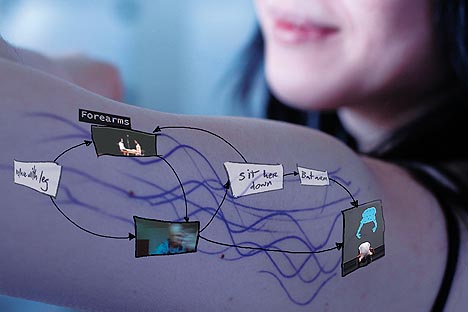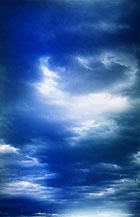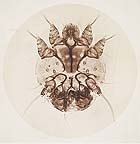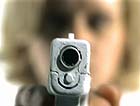
translated and summarized by: Liz Wollner-Grandville,
English summary April 27 - May 3
ZKM Karlsruhe: Notation. Kalkül und Form in den Künsten
In the early days of sonic imaging systems
“Notation – Kalkül und Form in den Künsten” (Notation – Calculation and Form in the Arts) was highly acclaimed by critics after it was first shown at the Berlin Academy of Arts. Now an extended version of the exhibition is shown at the ZKM in Karlsruhe. It gives a sensational insight into the pioneer days of art history when scientific experiments and mathematical operations were united with art concepts.
In 1880, when Etienne-Jules Maray commenced using photography as a means of recording to illustrate motion in space and time, this already approximates the abstract image sequence by the avant-garde film virtuoso Oskar Fischinger. His concept of setting musical compositions and visual sequences in congruence to one another opens up the path to today’s natural amalgamation of sound with motion pictures and the digital matrix of art, music, and club culture.
The exhibition at the ZKM focuses on pioneer developments in this area and is conceptualized as a multilayered puzzle. The underlying character of music, painting, choreography, architecture, photography, and film dating back to1900 and the subsequent development of digital art are retraced as complex sign systems and correlated on the basis of their linguistic characteristics. Designs by such diverging protagonists such as John Cage, Walter Benjamin, Mary Wigman, Ezra Pound, and Marcel Broothaers, Allan McCollum and Mel Bochner or Edgard Varèse and Iannis Xenakis evoke comparable versions of a genre-divisive art production.
This search for morphic resonances might be confusing, but this kind of extensive reflection facilitates the exposure of source codes as chains of permutation in terms of Friedrich Kittler’s denomination of Aufschreibesysteme (Discourse Networks or forms of notation). The masterminds of new aesthetic expressions hardly paid attention to taking tradition and technology into consideration.
The exhibition, curated by the Hubertus von Amelunxen, Dieter Appelt, and Peter Weibel, displaying nearly 500 positions by more than 100 artists, pursues the inception of integrating appliances into the production of art. Ultimately, this led to the current integration of sonic visual arts into the context of fine arts. Following the exhibition “Sons & Lumieres” at the Centre Pompidou in Paris in 2002, “Notation” is the unparalleled largest project of its kind. In addition, the theoretical content mediated by the accompanying catalogue, qualifies this compendium to be an independent publication.
By Roland Schöny
Notation. Kalkül und Form in den Künsten
ZKM Karlsruhe, until 26. 07.09
www.zkm.de/notation
MUSA – Museum auf Abruf: MOSTLY CLOUDY – transient phenomena in the sky
When the body becomes light
The City of Vienna’s art collection is extensive: in the past, its cultural office has arranged quite a few remarkable exhibits - exclusively using its own works. Including “Das Ding mit dem Foto”, 1999, “Vom Selbstzweck der Farbe”, 2001, and “Mutations”, 2007.
Currently, the Museum auf Abruf (MUSA) has devoted itself to the topic of clouds. The subtitle already points in the direction of the exhibition: to the ephemeral, intangible airy phenomena; optimally presented in Hubert Sielecki’s video: a text by Gerhard Rühm with obvious associations to all things transitory is recited parallel to the slow dissolution of a fleecy cloud - (“ … when the body becomes lighter, much lighter, … when the body becomes light in the light, the body becomes light and weightless…”). Siegrun Appelt’s installation is an additional good example - the motion of clouds is visible with the help of overlaying slides.
Josef Schwaiger’s increasingly monochrome colour streaks on aluminium illustrate the formal qualities of clouds and their artistic handling. And although the hanging of the works in the exhibition clearly points to the correlation, as well as the divergence, of the artistic focus, e.g. in Eva Schlegel’s and Elfriede Mejchar’s works, which both have a similar degree of abstraction although they were created with completely different techniques, the exhibition runs the risk of being too uniform. Half of the cloud paintings would have sufficed; many of them are rather insignificant and more decorative than anything else.
If the questionable quality of one or the other work depresses the exhibit’s standard, the mere quantity of a collection can be problematic. On the other hand the presentation offers surprising discoveries: for example the fact that Anton Lehmden’s aquarelle, which was probably created in 1950 “orbiting on the planet”, could easily have originated from a talented 21st century artist, is actually quite a surprise.
By Nina Schedlmayer
MUSA – Museum auf Abruf
1010 Vienna, Felderstrasse 6-8, next to the Vienna Town Hall, until 30.05.09
www.musa.at
Albertina: Photography and the invisible
Lights off, spotlight on: mange mite
March 4, 1840 - the stem of a clematis. Moth wings resembling a street map of Manhattan– which looked completely different at the time, in which Henry Fox Talbot’s photo was shot. These were Adalbert Stifter’s days. One can only vaguely imagine how these pictures revolutionized the perception of the world, and consequently that of art. It goes on: jumping spiders, mange mites, processionary moth. A hatching louse shown in a spectacular photo series created in the 1850s. And the all-time stars of micrographs, the diatoms, arranged as an aesthetic still life by Hans Hauswaldt in 1900.
Micrographs are only one chapter of the Albertina exhibit, but probably the most fascinating. In addition to making a microscopic part visible with the help of a camera, micrographs offered the, until then, unknown prospects of depicting motion. The most prominent examples were by Eadweard Muybridge, who not only presented somersaults, leaps, and birds in flight, but also the spanking of a child. One anticipated artists such as Duchamp and Picasso; and a more direct consequence was that painters realized that they had depicted galloping horses incorrectly. Or lightning, as one now realized, was not jagged, but frequently broken. Electric discharges and magnetic fields were now visible, the moon’s path across the sky, comets, the Milky Way.
X-rays made pellets visible, which were stuck deep in the flesh of soldiers’ hands, and frogs in the digestive tracts of snakes. One of the most delightful pieces is the x-ray still life of two lobsters on a table ready laid. Surrealists, cover your head before the magic of science – Touché for Jakob Ottonowitsch’s “a spark generated at the surface of a (thoroughly cleaned) body of a prostitute”, captivated on a plate by Narkiewitsch-Jodko in 1895.
By Iris Meder
Albertina
1010 Vienna, Albertinaplatz 1, until 24.05.09
www.albertina.at
Neue Galerie am Landesmuseum Joanneum: Rewind, Fast Forward – Video art from the collection of the Neue Galerie Graz from 1970 until today
In the magnetic field of the media avant-garde
The time to look back at video art seems favourable. The Neue Galerie in Graz is currently presenting an extensive historical panorama of video-based art.
Even if the gallery does not offer any headlines, which suggest chapters or linear historic developments, the topical intersections remain recognizable.
With challenging works on social developments, curator Günther Holler-Schuster creates one of the core themes. Among these works are those by Rainer Ganahl or Andreas Fogarasi, and the video of the open library in Hamburg by Clegg & Guttmann, 1991. Soon one discovers Marina Grzinic and Aina Smid's reflection of the subversive symbolism of the new Slovenian art - presenting performances by Slavoj Zizek. Topographically well positioned in the entrance hall are works and installations created in accordance with the aesthetics of surveillance. One of the few loans by Julia Scher is her surveillance and reception desk “Superdesk – Security by Julia”, 1993, while Jordan Crandall’s “Drive. Track 3” deals with the topic on large-format projections. Works by Paul Garrin, Peter Fend, and Andrea Fraser are also among the displayed objects.
The video “Kapellerstrasse 41” by Richard Kriesche, 1973, has great significance for Graz’ cultural story. With his video, Kriesche called attention to the - until then unknown misery to the public - of the barrack-like housing district of Graz. The work was first shown at trigon 73. Horst Gerhard Haberl introduced an international video art collection assembled for the trigon to Graz. Works by Joan Jonas, Merce Cunningham, Hermine Fried, John Baldessari or Andy Mann were represented at the trigon 73. However, the vision of creating Graz as the capital of the (at that time) new media was never implemented. In the catalogue, Christa Steinle, the current director of the Neue Galerie, mentions that her predecessor Wilfried Skreiner was in quest of the post-war avant-garde, but turned out to be an opponent of video art. As of 1990, Werner Fenz and Peter Weibel pushed for the expansion of the video-collection.
Not only does one encounter works by Valie Export or Gunter Brus, Milica Tomic or Trisha Brown, Mike Kelly and Paul McCarthy on the topic “body”, but also Friederike Petzold’s large format work “The new incarnated sign language”, 1973, and Frantisek Lesak’s ironically charged media reflexive work “Demonstrationsfeld”, 1973.
One day does not suffice to fully enjoy Dan Graham’s legendary video collage “Rock my religion”, 1982/84, or Bruce Nauman’s and Vito Acconci’s works. But it does not take long to realize that the Neue Galerie unfailingly purchases contemporary works, e.g. by Karina Nimmerfall, reMI, Anya Krautgasser or Norbert Pfaffenbichler, and Lotte Schreiber. The fabulous and extensive exhibition leads to the question why the Neue Galerie, in view of its potential, does not install space designated for permanent video presentations.
By Roland Schöny
Neue Galerie am landesmuseum Joanneum
8010 Graz, Sackstrasse 16, until 24.05.09.
www.neuegalerie.at
Mehr Texte von translated and summarized by: Liz Wollner-Grandville


 Teilen
Teilen





